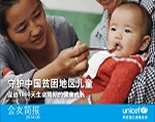NEW YORK, 19 November 2015 – Lack of access to toilets is endangering millions of the world's poorest children, UNICEF said today, pointing to emerging evidence of links between inadequate sanitation and malnutrition.
Some 2.4 billion people globally do not have toilets and 946 million – roughly 1 in 8 of the world's population – defecate in the open. Meanwhile, an estimated 159 million children under 5 years old are stunted (short for their age) and another 50 million are wasted (low weight for age).
A report issued today, Improving Nutrition Outcomes with Better Water, Sanitation and Hygiene, from UNICEF, USAID and the World Health Organization, for the first time brings together years of research and case studies which demonstrate the link between sanitation and malnutrition. More importantly, it provides guidance for action.
Lack of sanitation, and particularly open defecation, contributes to the incidence of diarrhoea and to the spread of intestinal parasites, which in turn cause malnutrition.
“We need to bring concrete and innovative solutions to the problem of where people go to the toilet, otherwise we are failing millions of our poorest and most vulnerable children,” said Sanjay Wijesekera, head of UNICEF's global water, sanitation and hygiene programmes. “The proven link with malnutrition is one more thread that reinforces how interconnected our responses to sanitation have to be if we are to succeed.”
Diarrhoea accounts for 9 per cent of the deaths of children under 5 years old each year and is essentially a faecal-oral disease, where germs are ingested due to contact with infected faeces. Where rates of toilet use are low, rates of diarrhoea tend to be high.
Children under 5 years old suffer 1.7 billion cases of diarrhoea per year. Those in low income countries are hit hardest, with an average of three episodes per year. The highest frequency is in children under 2 years old, who are weakest and most vulnerable. Multiple episodes of diarrhoea permanently alter their gut, and prevent the absorption of essential nutrients, putting them at risk of stunting and even death.
Some 300,000 children under 5 years old die per year – over 800 every day – from diarrhoeal diseases linked to inadequate water, sanitation and hygiene. The poorest children in sub-Saharan Africa and South Asia are particularly at risk.
Intestinal parasites such as roundworm, whipworm and hookworm, are transmitted through contaminated soil in areas where open defecation is practiced. Hookworm is a major cause of anaemia in pregnant women, leading to malnourished, underweight babies.
Some countries have made significant progress in addressing both access to sanitation and the nutritional status of their children. Many have successfully used UNICEF's Community Led Total Sanitation approach, in which the affected populations themselves devise local solutions to the problem of open defecation.
-
Pakistan met the 2015 Millennium Development Goal to halve the proportion of people who in 1990 did not have access to improved sanitation. Using CLTS, entire communities abandoned the practice of open defecation, leading to improved health and nutrition indicators among their children.
-
Ethiopiamobilized community workers and achieved the largest decrease globally in the proportion of the population who defecate in the open. Despite population growth, the practice reduced from 92 per cent (44 million people) in 1990 to 29 per cent (28 million people) in 2015.
-
In Mali the CLTS approach was also used in communities with high malnutrition rates, exacerbated by drought in the Sahel region. Improved access and use of latrines ensued, and improved health and nutrition in children.
-
During the emergency linked to conflict in the Democratic Republic of the Congo, integrated nutrition and WASH interventions were used for displaced communities. Children under 5 years old saw significantly reduced undernutrition and waterborne diseases. Around 60 per cent of the population constructed latrines and some 90 per cent of malnourished children returned to normal weight during a 12-month period.
“There are no excuses not to act on access to toilets, even in the poorest communities, or during emergencies,” said Wijesekera. “On the other hand, there are millions of reasons – each one a child who is stunted or wasted, or worse, who sickens and dies – to treat this with the urgency it deserves.”
About UNICEF
UNICEF promotes the rights and wellbeing of every child, in everything we do. Together with our partners, we work in 190 countries and territories to translate that commitment into practical action, focusing special effort on reaching the most vulnerable and excluded children, to the benefit of all children, everywhere. For more information about UNICEF and its work visit: www.unicef.org
Visit UNICEF China website: www.unicef.cn
Follow us: Sina Weibohttp://weibo.com/unicefchina Tecent Weibo http://t.qq.com/unicef
Wechat: unicefchina

For further information, please contact:
Rita Ann Wallace, UNICEF Media, Tel +1 212 326-7586, Mobile: +1 917 213-4034, rwallace@unicef.org;
Shantha Bloemen, UNICEF China, +8610 85312610, sbloemen@unicef.org
Liu Li, UNICEF China, +8610 85312612, liliu@unicef.org





























